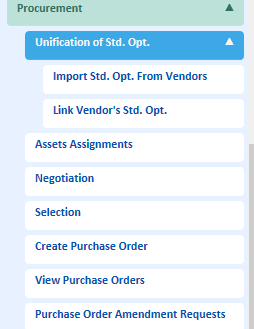The Procurement Module covers all of the workflow required to develop and issue comprehensive electronic purchase orders. The work process normally involves ensuring that all standard options, accessories, disposables, consumables and spare parts are included in the order. Following that, negotiations with bidders is facilitated using the online vendors’ portal. Upon the successful negotiations, selections can be made for each component in a package or requisition.
The complete selection will then be automatically populated in the purchase orders which can be migrated to an ERP system. In addition to the standard PO format, Pequip will capture all warranty requirements, all shop drawings requirements, and will segregate OPEX vs. CAPEX elements thus allowing for accurate receiving, invoice payment approvals, and depreciation of the capital equipment. In some countries where sales tax is applicable, the PO will automatically calculate the amounts based on a percentage that will be recorded in the Project Set-Up Menu. For contracts that require future materials approvals and selection, amendments of purchase orders is possible to add exact make, models and options and accessories.
Partial List of Benefits:
- By linking the procurement process with the project schedule, customers can better plan when they should we make the selection of the Architectural Significant Equipment so that the site will be prepared according to specific make and model requirements. This will avoid needing to tear down walls and make site modifications after construction was completed.
- Customers can better plan when they should issue purchase orders based on room readiness.
- Including all details in the purchase orders and covering all project requirements will not leave room for future variations.
- By having Pequip generate comprehensive purchase orders, all PO data can be easily migrated to the customers ERP system.
- Bundling items in tender packages will facilitate getting more competitive offers and reducing total cost to the customers.
- Aggregating equipment purchases will optimize capital spend volume, and achieve subsequent discounts.
- Consolidating shipments will further reduce total costs as freight cost can account to 20% of the total cost.
- Differentiating between capital cost that is depreciable and operating cost such as freight, taxes, customs, consumables and disposables will recognize expenses in the proper chart of account.
- Accessing Group Purchasing Organizations pricing, local, regional, national and/or government contracts that is available to the facility can reduce procurement costs.

